

Received: 8/23/2000 2:41:46 AM Sender: Ted A. Nichols II Mailing List: ShallowSky (E) Subject: Discovery of a possible new Lunar Ray? Greetings, After the Public Observing Session this Past Sunday Night at the Naylor Observatory in Lewisberry. A group of members decided to look at the moon, thanks to Tony Donnangelo for prompting us to do so! We all noticed a Lunar Ray. The ray was located in a small walled plain area just east of the crater F, and west of the larger walled plain Alexander. It was lying north of, perpendicular to, and between the two craters Calippus and C. ( A side note - This ray ran right up the Caucasus Mountain.) In UT, the ray was observed at 04:00 UT at 2000/8/21. See Rukl Chart 13 for the location. Fellow members Tony Donnangelo, Robert Pody, Joe Rossi, Rob Job, and I were present to confirm, watch the ray, and browse through books for information. Members also noticed an interesting feature in Calippus, but we are now leaning to the idea, it wasn't a lunar ray but the top of a ridge or mountain area in a crater. It looked much smaller than the large ray mentioned above, and we are almost positive it is just the top of a crater feature in Calippus. The ray was observed from the following coordinates, ASH Naylor Observatory, Lewisberry, Pa. , 40.15 N, 76.9 W. We are at an elevation of 570 feet. The ray was observed through a 12.5" Cave Newtonian (F/6.5 2064 MM). With a 16 mm Brandon Eyepiece at 129X. We may have a "group" discovery, thanks to a "group" effort.. The sun was shining on the western limb, so this would be a SUNSET way. The moon stage was a waning gibbous. This ray was quite long, and thin compared to the pictures of other lunar rays I have seen. If anyone has any details on this, or if it's a first, if they could contact me I'd appreciate it. We may have one excited group of individuals here :) Regards, Ted A. Nichols II Astronomical Society of Harrisburg-------------------------------------------------------------------------------
A group of amateur astronomers on 2000/8/21 at 04:00 UT observed from Naylor Observatory in Lewisberry Pa. located at 40.15 N, 76.9 W, and at an altitude of 570 feet, a Lunar Ray. It was located approximately 40.5 N, 10.5 E. It was lying north of, perpendicular to, and between the two craters Calippus and C in a small plain area just east of the crater F and west of the walled plain Alexander. Location can be found on Rukl Chart # 13.
We were observing with a 12.5 Cave Newtonian , F 6.5 with a 2064 mm focal length, using a 16 mm Brandon at 129X. It can easily seen in smaller scopes and various eyepieces.
I again saw it on 2000/10/19 at 4:34 UT. It may be able to be seen at an earlier hour. This is the earliest that I could see it from my location. I have seen it twice more since then. It can also be seen easily in a low power eye piece in a wide field view. During the same time, the top of the interior mountains of Calippus are lit up making it look somewhat like the face of a clock.
I would appreciate it if anyone else who may have seen this would e-mail me. I would also appreciate it if we could get an independent conformation. I haven t yet calculated its next occurrence. It can be done with the lunar calculator used by David Darling of ALPO. I had contacted David Darling about our sighting when it first occurred. He was going to photograph it, but never heard from him that he ever did it.
Thank you, Tony Donnangelo Vice-President; Astronomical Society of Harrisburg
By running predictions using site coordinates, date and time of the event, it was determined that the event could be seen when the sun was 3.537 degrees setting, with an average colongitude of 164.753 degrees. This data was used to compute the predictions, found on the prediction page.
Starting Date = 2000 / 8 / 21 U.T.
Site Longitude = 76.90 Latitude = 40.15 Elevation = 173 meters
Feature = CALIPPUS
Longitude = 10°42' Latitude = 38°54'
Reproducing Lighting For: 2000 / 8 / 21 at 4 : 0 UT
Desired Solar altitude = 3.537° (Setting), Azimuth = 268.301°
Average Co-longitude = 164.753
In the time column, D=daylight, T=twilight
---- Moon's ----
Topocentric -- Earth's -- ------- Sun's -------
UT Date Time Alt° Semi-diam" long° lat° colong° lat° azim°
2000/10/19 5:34 30.50 974.00 -0.54 0.91 165.98 1.52 269.10
2000/12/17 8: 0 42.89 973.33 5.68 -5.92 165.17 0.52 267.81
2001/ 2/14 10:31 36.99 942.46 7.73 -5.60 163.89 -1.06 265.77
2001/ 4/14 12:28d 21.02 908.21 3.90 0.35 163.54 -1.49 265.21
2001/ 6/12 13:24d 20.22 895.87 -2.11 5.81 164.44 -0.40 266.63
2001/ 8/10 13:39d 26.90 910.52 -6.14 6.24 165.64 1.09 268.55
Calippus, +142,+627 - This formation is somewhat deformed, being decidedly oval from east to west, as though it had been subjected to pressure in the past. It is 19 miles in diameter, and there are hills on the interior, the highest being a little south of centre. On the east is a curved mountain arm, the relic of an old ring and rising 13,000 feet above the plain at its foot. To the north-east, near a low ring, is a great mountain, its lofty summit rising over 18,000 feet; the highest in the Caucasus range, and very prominent under low illumination. On the west is the broken and dicontinuous border of Alexander, and with only one peak of any note, south is the peculiar, low, triangular object, Y. - Wilkins and Moore, The Moon, Faber and Faber, 1955

